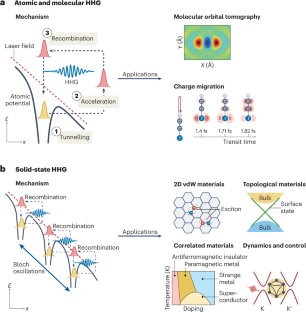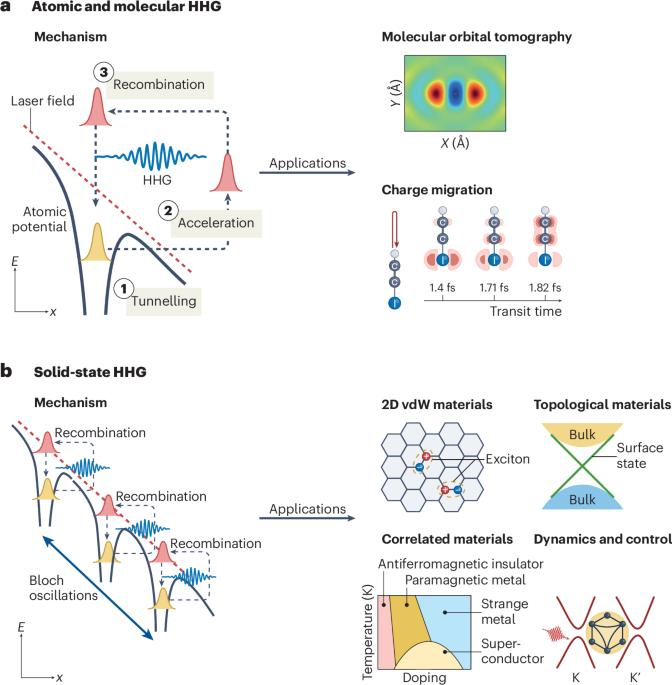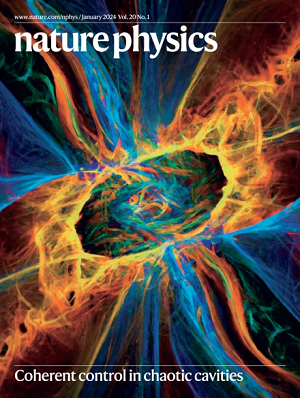固体超快高次谐波光谱学
IF 18.4
1区 物理与天体物理
Q1 PHYSICS, MULTIDISCIPLINARY
引用次数: 0
摘要
高次谐波光谱学是一种超快全光学技术,最初是在原子和分子系统中提出的概念,现已成为研究凝聚态物质结构和动力学的强大平台。与气相不同,固态高次谐波的产生依赖于高原子密度和周期性的基本响应,从而导致带间跃迁以及电子和空穴在各自带内的相干驱动。这些机制使得高次谐波光谱学对凝聚态介质中的电子能带结构、拓扑特性和多体相关性特别敏感。与其他光谱学方法相比,高次谐波光谱学的优势在于它能够探测超快现象,捕捉固体中多波段和强相关电子相互作用的飞秒到阿秒级动态。在这篇综述中,我们将讨论固体超快高次谐波光谱学的最新实验和理论进展,并为这一领域的未来研究提供展望。本文章由计算机程序翻译,如有差异,请以英文原文为准。


Ultrafast high-harmonic spectroscopy of solids
High-harmonic spectroscopy, an ultrafast all-optical technique initially conceptualized in atomic and molecular systems, has now emerged as a powerful platform for studying the structure and dynamics of condensed matter. Unlike that in the gas phase, solid-state high-harmonic generation relies on the fundamental response from high atomic density and periodicity, leading to interband transitions and coherent driving of electrons and holes in their respective bands. These mechanisms make high-harmonic spectroscopy particularly sensitive to the electronic band structure, topological properties and many-body correlations in condensed media. An advantage of high-harmonic spectroscopy over other spectroscopic methods is its ability to probe ultrafast phenomena, capturing femto- to attosecond dynamics of multi-band and strongly correlated electron interactions in solids. In this Review, we discuss the latest experimental and theoretical advances in ultrafast high-harmonic spectroscopy of solids and provide perspectives for future research in this field. High-harmonic spectroscopy on solids is an ultrafast all-optical technique to study the structure and dynamics of materials. This Review discusses areas of condensed-matter physics where this technique can provide particular insight.
求助全文
通过发布文献求助,成功后即可免费获取论文全文。
去求助
来源期刊

Nature Physics
物理-物理:综合
CiteScore
30.40
自引率
2.00%
发文量
349
审稿时长
4-8 weeks
期刊介绍:
Nature Physics is dedicated to publishing top-tier original research in physics with a fair and rigorous review process. It provides high visibility and access to a broad readership, maintaining high standards in copy editing and production, ensuring rapid publication, and maintaining independence from academic societies and other vested interests.
The journal presents two main research paper formats: Letters and Articles. Alongside primary research, Nature Physics serves as a central source for valuable information within the physics community through Review Articles, News & Views, Research Highlights covering crucial developments across the physics literature, Commentaries, Book Reviews, and Correspondence.
 求助内容:
求助内容: 应助结果提醒方式:
应助结果提醒方式:


